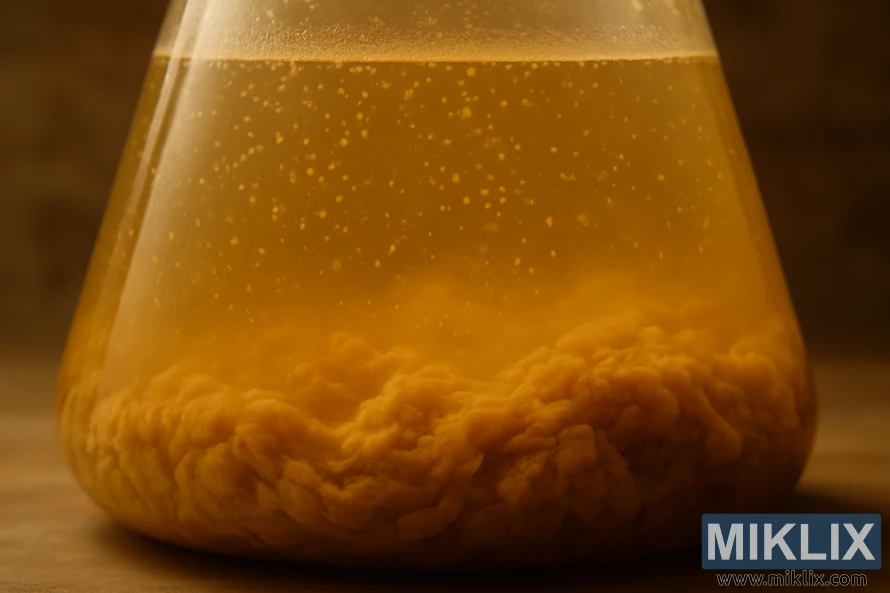Image: Flocculation in a Conical Fermenter
Published: September 28, 2025 at 10:27:48 PM UTC
A close-up of a conical fermenter with golden hazy liquid, yeast flocs, and sediment settling, highlighting the lager flocculation process.
The image presents a close-up view of a conical fermenter, its transparent glass walls filled with a golden-hued liquid in the midst of lager fermentation. The scene captures a precise and fascinating stage of the process known as flocculation, when yeast cells aggregate and settle to the bottom of the vessel. The photograph emphasizes this biological and chemical drama, transforming a scientific observation into a visually rich display of textures, colors, and movement.
The fermenter dominates the frame, its conical base tapering gently downward to a rounded point where the yeast sediment has collected. At the very bottom of the vessel lies a thick, fluffy layer of yeast flocs. These sediment formations are irregular and cloud-like, resembling soft mounds of fibrous material. Their shape suggests both density and delicacy: a mass substantial enough to rest in place yet light enough to shift and swirl in response to subtle convection currents within the liquid. The texture is striking, with folds, ridges, and tuft-like surfaces that lend an organic quality to the yeast bed.
Above this sediment, the liquid itself is hazy and golden, filled with suspended particles of yeast still in motion. Countless tiny specks scatter throughout the medium, illuminated by the soft, indirect light that filters through the glass. These suspended flocs shimmer faintly as they catch the light, evoking a sense of life and activity even as they slowly drift downward. The overall tone of the liquid ranges from a bright, honeyed gold near the upper regions to a deeper, more saturated amber toward the base, where concentration and density increase.
The interaction between the liquid and the sediment at the bottom creates a layered effect. The photograph seems almost divided into two parts: the upper half alive with floating particles, and the lower half dominated by the thick yeast bed. Yet the boundary between these layers is not sharp. Instead, it is dynamic and porous, with sediment occasionally detaching in small tufts to rise briefly before drifting back down. This interplay communicates the ongoing process of settling and separation, embodying the essence of flocculation.
Lighting enhances the image’s mood and detail. A warm, indirect glow bathes the fermenter, highlighting the golden translucency of the liquid and the intricate textures of the yeast flocs. Shadows are soft, almost velvety, deepening the amber tones while maintaining a sense of depth and dimensionality. Highlights sparkle faintly on suspended bubbles and yeast specks, creating an impression of vitality. The background remains unobtrusive and softly blurred, ensuring that all visual energy is concentrated on the fermenter’s interior.
The composition emphasizes scientific observation while also revealing the aesthetic beauty of fermentation. The image does not attempt to dramatize with external props or clutter; rather, it draws attention solely to the natural behavior of yeast in a carefully controlled environment. At the same time, the textures, colors, and interplay of light elevate the subject beyond mere documentation. The photograph becomes a celebration of the microbial world and its role in crafting beer, particularly the clean, crisp lager styles that depend on yeast’s tendency to flocculate and settle.
Altogether, the image conveys a sense of balance: between science and art, between activity and stillness, between suspension and sedimentation. It captures a fleeting moment in the ongoing story of fermentation—a stage that is as essential as it is overlooked. To the brewer, this settling marks progress toward clarity and refinement. To the observer, it reveals the hidden choreography of microscopic life, rendered visible through glass, light, and patience.
The image is related to: Fermenting Beer with White Labs WLP850 Copenhagen Lager Yeast

